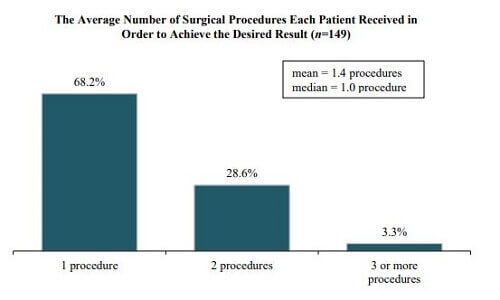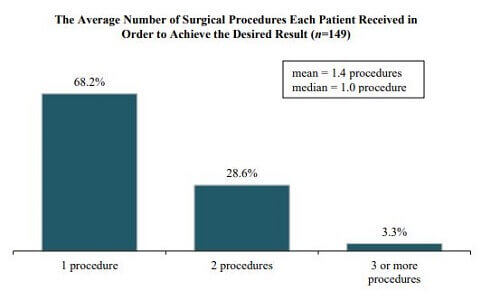Medications have enabled me to hang on to a large portion of my hair. However, the follicles are incapable of growing long due to a short anagen phase cycle throughout the scalp. The area above my ears cannot even grow one inch in length before dying or shriveling up. And some areas of my scalp are sparser than others.
How Many Hair Transplants do you Need?
Eventually, I will have to choose between shaving it all off or getting a hair transplant. Unless a greatly improved hair loss treatment comes along. I do not like the messy dishevelled look, nor a combover. I also do not like the idea of shaving my head every week in case I go for the barren look. I know I will shave weekly due to having some obsessive compulsive disorder (OCD) and body dysmorphic disorder (BDD) tendencies.
One of the reasons that I am wary about getting a hair transplant is because I am certain that I will need more than one procedure. I feel like the vast majority of patients need two procedures. Moreover, if you are unlucky, even your “permanent” donor hair at the back of the scalp can thin out before old age. Meaning that over the years you may lose some of it after it is transplanted to the front, and then require a second hair transplant. My mother’s father lost most of his “permanent” donor hair before he hit his 70s, although he never took any hair loss medications.
Having said all of the above, according to the ISHRS 2022 practice census hair transplant statistics:
“Two-thirds (68.2%) of members reported performing an average of one procedure to achieve the desired hair restoration result. The average number of procedures needed to achieve the desired hair restoration result was 1.4.”
I would still go with my guess of 2.0 rather than 1.4. If the ISHRS were to follow these one-and-done patients for 20 years, I bet that the majority do end up getting a second hair transplant in the long run. Or at least wanting a second one, but not going through with it for various reasons.
In the ISHRS census chart, only 28.6% of patients needed two procedures, and just 3.3% of patients needed three procedures.

Obviously these statistics are impacted by many factors including:
- The size of each procedure. FUE procedures tend to be smaller than FUT/Strip procedures. See my post on FUE versus FUT.
- The need for any separate repair or scar revision surgeries.
- Whether someone has a small body hair transplant (BHT) filler procedure.
- Donor hair graft quantity and quality.
- Scalp laxity when it comes to extraction.
- Patient preference for a small versus large session.
- Surgeon comfort level in performing larger one time megasessions (or even gigasessions).
It is extremely rare to hear of anyone who has had more than four hair transplants in their lifetime. Most people seem to get two and are done. However, some do go crazy.
Hair Transplant Addiction
On this site, I have covered the two most prolific hair transplant recipients in the world (Spex and Joe) many times.
Obviously, some of these procedures were very small and entailed repair work or scar revision. Joe had some initial surgeries to repair prior bad work. He also had a small body hair transplant procedure. I do not know much about most of Spex’s various procedures.
Both these major hair loss world influencers have access to their choice of leading surgeon. Moreover, I am assuming that they can get free procedures from any quality surgeon nowadays if they document the work in return.
I thought that no-one would ever come close to ever matching Joe and Spex when it comes to this crazy statistic. Besides the significant cost of a single hair transplant procedure, no-one I know likes to go under the knife on a regular basis. Then I read something crazy last week, and further research led to finding yet more anomalies.
Christopher Maloney had 8 Hair Transplants
Singer Christopher Maloney became a viral hit on the UK X Factor show in 2012. His major nervousness as well as stellar voice garnered him a lot of fans. Including 87 million views of the below video:
Last month, the Daily Mail covered the now 45-year old Mr. Maloney’s obsession with plastic surgery. He has “uncontrollable body dysmorphia”.
“My body dysmorphia, my anxiety and depression has taken over my life. In the past 12 months it’s gone into overdrive.”
One fact in the article struck me more than anything else:
Mr. Maloney has had 8 hair transplants (and 7 nose jobs)!
He seems to go to Poland for most of his procedures. In general, people who suffer from BDD will never be willing to get covered in the media. I have to give kudos to Mr. Maloney for sharing his story so publicly. And for having the courage to sing in front of the world.
Interestingly, in the Daily Mail article, Mr. Maloney blames stress for causing his initial hair loss. i.e. telogen effluvium. But that usually reverses itself after a while. In my opinion, he always had thin hair and likely suffers from androgenetic alopecia (AGA). Chris’s new hair looked good the last time he updated his Instagram a few months ago.
Joe Buck had at Least 8 Hair Restoration Procedures
Well known US sports announcer Joe Buck had his eighth hair transplant in 2011. His story makes for a very interesting read. For a long time he lied to people about an unusual surgery related side effect in order to avoid discussing his “hair plug addiction”.
He had his first ever procedure in 1993 in New York at the age of 24.
“As a young man, one of Buck’s overwhelming fears was losing his hair, and the possibility soon consumed him.”
Calum Best and James Nesbitt: 6 Each
- Also of note, UK reality TV star Calum Best had his sixth hair transplant several months ago. It involved moving beard hair grafts (including from just beneath his neck) to his scalp. In his own words:
“I feel so much better about myself. If science can sort out a problem, why not use it if it is going to improve your mental health and put a smile on your face?”
Calum does not want to take medications such as Finasteride due to any potential side effects. So his hair loss has continued at a faster pace than that of hair restoration patients who are on hair loss drugs.

